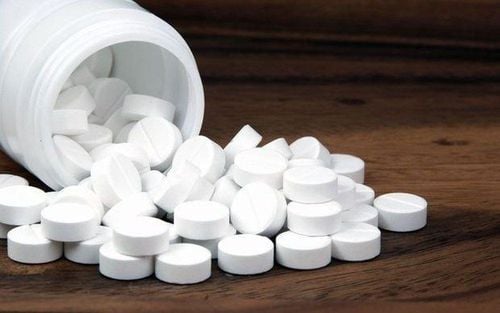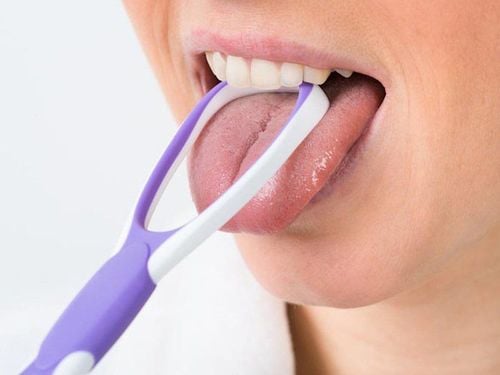This is an automatically translated article.
The article was professionally consulted by Doctor of Dentistry - Jaw - Face - Department of Medical Examination & Internal Medicine - Vinmec Hai Phong International General Hospital.
If you have a chipped tooth, you may not feel any pain unless the tooth is large enough to expose the nerves in the inner layer of the tooth. You may notice that your teeth are more sensitive and painful when you chew or when your chipped teeth come in contact with foods and drinks that are too hot or too cold. So how to treat chipped teeth?
1. What is a chipped tooth?
If you have a chipped tooth, you may not feel any pain unless the tooth is large enough to expose the nerves in the inner layer of the tooth. If a chipped tooth exposes the nerves inside the tooth, you may notice more sensitivity and pain when chewing or when your chipped tooth comes in contact with foods and drinks that are too hot or too cold. A piece of debris on one of the sharp chewing surfaces of the posterior tooth is called a crown fragment. This type of chipped tooth is rarely painful but needs to be seen by a dentist. You may need a crown or a dental coating to restore the shape of your tooth and prevent further damage or decay.
A cracked tooth can affect only the enamel, or it can affect the entire tooth down to the root. You may only experience pain from a cracked tooth when chewing or when the temperature in your mouth changes when you eat something hot or cold. But it's important to see a dental professional as soon as possible after you discover a cracked tooth, so that it can be evaluated and treated if necessary.
Cavities : Tooth decay can weaken your teeth and cause you to chip . Evil bite : Biting on a hard object, such as an ice cube, a piece of hard candy or a bone. Hitting: Injury to the face or mouth, such as being hit in the face by a ball while playing sports. Poor hygiene: Poor oral care can make you more likely to chip or crack your teeth, especially if your enamel is already damaged or thinning. Teeth grinding: Excessive teeth grinding, known as bruxism, can cause teeth to chip or crack or crack.
Trắc nghiệm: Thử hiểu biết của bạn về răng
Răng là bộ phận quan trọng, giúp một người sử dụng miệng để ăn, nói, cười và tạo hình dạng cho khuôn mặt của họ. Tuy nhiên, có những sự thật thú vị về răng mà có thể bạn chưa từng biết. Hãy cùng trả lời nhanh 9 câu hỏi trắc nghiệm sau để thử hiểu biết của bạn về răng.
Bài dịch từ: webmd.com

2. Treatment of chipped teeth
Small batch: If the debris in your tooth is very small, your dental professional can simply sand and polish the chipped tooth and no further treatment is needed.
Medium Batch: If your chipped tooth involves minor damage to enamel, your dental professional will likely place a filling, crown, or cap over the chipped tooth to restore it. to its normal shape and function and to protect the inner layers of the tooth from irritation and infection.
Large batch: If your chipped tooth is large enough to expose the tooth nerve, you will likely need a root canal to remove the damaged nerve, plus a crown or cap to replace the chipped tooth. .
Primary Care: If you have a chipped tooth, make an appointment with a dental professional as soon as possible. Meanwhile, follow these steps:
Gargle : Gargle with warm water. Compression: If bleeding in the mouth is caused by a chipped tooth, apply a gauze pad to the area. Covering: If you are unable to see a dental professional on the same day the chipped tooth occurs, apply dental cement (available at most pharmacies) to protect the remaining tooth until you to the appointment. Post-treatment care: After treatment for a chipped tooth, it is important to maintain a regular oral care routine. To help you maintain your twice-daily brushing and flossing habits.
3. Treatment of cracked teeth
Simple cracked teeth: Simple cracks in the enamel are also known as “crack lines”. This type of cracked tooth may not require treatment, but you should still see a dental professional for an evaluation. Your dental professional can polish the cracked tooth to smooth rough spots and improve the appearance of the tooth.
Severely cracked teeth: If you have a severely cracked tooth, the crack can extend from the chewing surface of the tooth down to the root. If you have a severely cracked tooth that passes through the outer layers of enamel and dentin to expose the pulp, the tooth may become loose and your gums may bleed.
Split teeth : In some cases, a cracked tooth will split vertically. If this happens in one of your molars, your dental professional can save one of the two roots the molar has. If the root of the tooth is damaged too badly, you will have to have the tooth extracted and replaced.
Root separation : A cracked tooth can also start at the root. This type of tooth is clearly cracked and painful, can cause inflammation and infection at the root, often extraction is the only treatment.
Options for treating a cracked tooth depend on the severity of the crack and should always be treated by a professional, including:
Tooth bonding : A cracked tooth can sometimes be repaired with an adhesive, in which a tooth-colored resin is used to repair or reshape the tooth. Braces: If a tooth is loose or displaced, your dental professional can bond the cracked tooth to the adjacent tooth to help keep it stable while the surrounding bone and gum tissue heals. Pulp: If a cracked tooth has damaged the pulp, you may need a root canal to remove the damaged material, as well as crowns, fillings or adhesives, to restore the cracked tooth and prevent it. further damage.

4. Cracked tooth syndrome
Soreness is caused by a number of potential causes, including tooth decay, gum disease, and tooth sensitivity. But teeth are also damaged by external influences. Cracked tooth syndrome causes tooth pain when you bite into a cracked or broken tooth.
Cracked tooth syndrome begins with the development of cracks in teeth that are too small to show up on dental x-rays. Cracks can occur from chronic teeth grinding (bruxism) or because the alignment of the teeth or jaw puts disproportionate pressure on a certain tooth or teeth. Cracked teeth often make molars or decayed teeth painful, as they do most of the chewing work. If you have cracked tooth syndrome, you may only notice pain when you bite down in a certain way, as opposed to the more frequent toothache associated with tooth abscesses or cavities.
Your dental professional may use special tools to examine your teeth for possible cracks. Treatment is usually a crown for mild cases, but if the fracture affects the pulp, a root canal may be needed. If the tooth crack is deeply rooted in the jawbone, the tooth needs to be extracted.
Dental - Jaw - Facial - Vinmec International General Hospital specializes in examining and treating all common dental problems in adults and children. The hospital has a team of qualified doctors and dentists and a system of advanced machinery to help support the examination process well and shorten the time.
Therefore, when there is any problem, you can go to the hospital to be checked for appropriate instructions from a specialist doctor. Avoiding leaving for a long time will affect the structure and aesthetics of the teeth.
Please dial HOTLINE for more information or register for an appointment HERE. Download MyVinmec app to make appointments faster and to manage your bookings easily.













